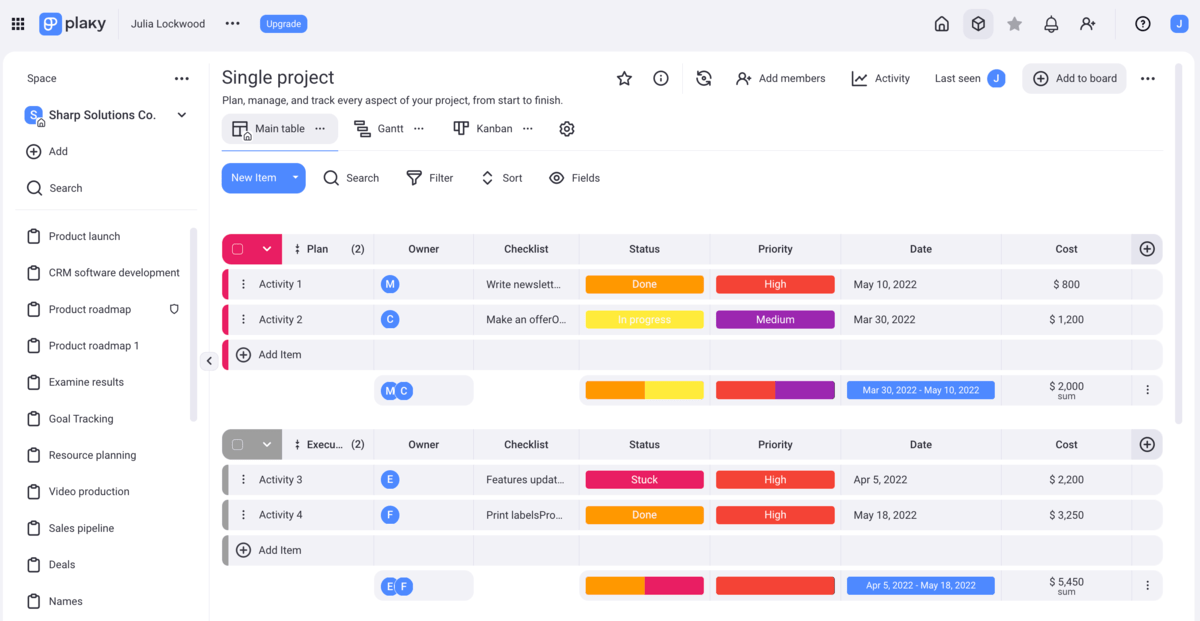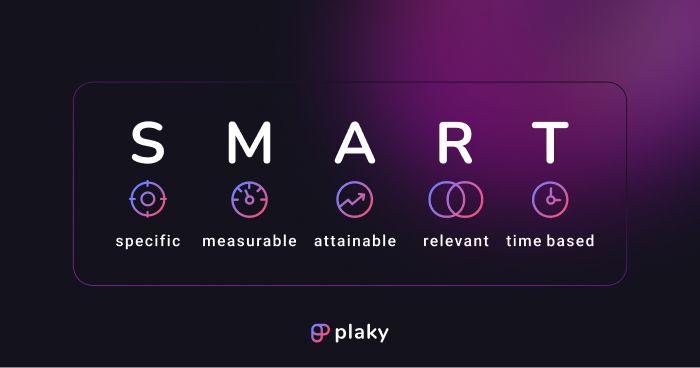What Are the Phases of Project Management?

Managing projects can be an overwhelming experience, especially if you don’t have a clear picture of all the steps you have to take during the project.
Therefore, it requires breaking down the project into phases and specifying what needs to be carried out in every particular phase.
Every project consists of these five project phases:
- Initiation
- Planning
- Execution
- Monitoring and control
- Closure
This guide will walk you through project phases and explain them in more detail. Also, it will suggest the steps you should take to complete each phase successfully.
Table of Contents
Phase 1: Project Initiation
The first phase in a project life cycle is the project initiation phase.
In this phase, you have to:
- Determine the project’s vision and objectives,
- Document what you want to accomplish, and
- Secure approvals from project stakeholders.
Here are the steps you need to take to achieve these objectives.
How to initiate a project?
The steps you should consider taking to make the project initiation phase go smoothly include the following:
- Step #1 Create a business case
- Step #2 Conduct a feasibility study
- Step #3 Develop a project charter
- Step #4 Determine stakeholders and create a stakeholder register
- Step #6 Select project management tools
Let’s explain every step.
Step #1 Create a business case
First, you should create a business case. According to the Association for Project Management (APM), a business case “provides justification for undertaking a project, programme or portfolio.”
This document explains why the company should spend its resources on a specific project.
Also, its purpose is to convince the upper management to approve the project. Additionally, the business case addresses management’s potential concerns about any business or financial risks.
Step #2 Conduct a feasibility study
After the business case approval, you should undertake a feasibility study.
Investopedia defines a feasibility study as “an assessment of the practicality of a proposed plan or project.”
It’s a way to evaluate the project’s potential for success.
It also helps to identify potential issues and problems that could arise.
To determine whether a project can succeed, a feasibility study considers:
- Economic factors,
- Legal factors,
- Technical factors, and
- Scheduling factors.
Step #3 Develop a project charter
Did you know that some project management professionals view the project charter as the project’s best marketing tool? This perfectly illustrates the importance of this document.
The project initiator or sponsor issues the project charter — a document that formally authorizes the existence of a project.
Moreover, the project charter gives the project manager the authority to apply organizational resources to project activities.
Examples of organizational resources include team members, capacity, budget, equipment, technology, etc.
A project charter also provides a direct link between the project and the organization’s strategic objectives. Moreover, it shows the organizational commitment to the project.
Step #4 Determine stakeholders and create a stakeholder register
There is no project without project stakeholders. In gist, stakeholders are all the people that have an influence on or can be influenced by the project.
A stakeholder register lists all project stakeholders. It is, basically, an index of all project stakeholders and their critical attributes.
You should create this register as early as possible in the project life cycle.
If you don’t determine all the parties interested in your project who can have an influence on it, the chances are high that your project is doomed to fail right at the start.
Therefore, this step is one of the most critical ones.
Step #5 Select project management tools
The final step in the initiation phase is about choosing project management tools.
A project management software, like Plaky, can help you:
- Organize your project,
- Always know what your team members are doing, and
- Effectively track project progress.

🎓 Plaky Pro Tip
Get expert tips on how to start a project in just a few steps in the post below:
Phase 2: Project Planning
“If you fail to plan, you are planning to fail!”
In the project planning phase, we intend to build a project roadmap.
Proceeding to the execution phase without planning a project leaves you at risk of overrunning available resources and failing to reach your goals.
How to plan a project?
After you have successfully completed the initiation phase, you are ready for project planning.
This phase consists of the following steps:
- Step #1 Determine project goals
- Step #2 Define a project scope
- Step #3 Prepare a work breakdown structure (WBS)
- Step #4 Develop a project schedule
- Step #5 Plan resources
- Step #6 Develop a communication plan
- Step #7 Develop a risk management plan
- Step #8 Plan budget
- Step #9 Choose your preferred project management methodology
Nine steps may seem like a lot, but worry not — we will go through all of them.
Step #1 Determine project goals
There are several methods to set up your project goals. Let’s look at the two most popular ones — S.M.A.R.T. and C.L.E.A.R.
S.M.A.R.T. goals definition and example

S.M.A.R.T. goals are Specific, Measurable, Attainable, Relevant, and Time-based goals:
- To make goals Specific — Specify what exactly needs to be done.
- To make goals Measurable — Define goals so that you can measure them.
- To make goals Attainable — Make sure your goal is realistic and can be achieved.
- To make goals Relevant — The goal should be relevant for completing your project.
- To make goals Time-based — Every goal needs a target date.
Let’s provide a S.M.A.R.T. goal example.
Suppose your company wants to create a CRM software for the internal use of your marketing and sales teams.
In this case, your S.M.A.R.T. goal can look like this:
Create a CRM software that organizes at least 3000 incoming inquiries per week so that our team can organize these inquiries and reply to them within 24 hours of receipt.
- Specific: Create a CRM software
- Measurable: that organizes at least 3000
- Attainable: incoming inquiries per week
- Relevant: so that our team can organize these inquiries
- Time-based: and reply to them within 24 hours of receipt.
C.L.E.A.R. goals definition and example

C.L.E.A.R. stands for Collaborative, Limited, Emotional, Appreciable, and Refinable goals.
- Collaborative goals — They should engage your team and encourage people to work together.
- Limited goals — They are limited in time and scope.
- Emotional goals — They should feel emotionally significant to employees, making them passionate to reach them.
- Appreciable goals — Large goals are broken into smaller, measurable steps.
- Refinable goals — They can be refined and modified as new situations or information arise.
Let’s provide a C.L.E.A.R. goal example.
Imagine your company wants to develop a team chat app for internal use and plans to offer it to clients in the near future.
A C.L.E.A.R. goal for this project can look like this:
- Collaborative: Our marketing, product, development, design, and testing teams will work together to create a business chat app.
- Limited: We dedicate six months to finish this project.
- Emotional: This app will enable our teams to communicate more efficiently.
- Appreciable: Marketing and product teams will have a month to specify functionalities. After that, the design team will also have two weeks to come up with at least two design proposals and two weeks for work on adjustments. Then, the development team will have three months to complete work on functionalities. The final step, testing, will last for one month.
- Refinable: The adjustments on scheduled time and functionalities can be made based on information we obtain through the project. For instance, we may discover that customers would like some functionalities that we didn’t plan initially by reading reviews they left for our competitors’ similar apps.
Step #2 Define a project scope
If you are a project manager, you undoubtedly know the importance of effective project scope.
The Australian Institute of Project Management (AIPM) defines a project scope as “an agreed summary of all the important parameters of the entire project,” like the following:
- Goals,
- Deliverables,
- Tasks,
- Costs, and
- Deadlines.
According to AIPM, the project scope is vital because it establishes:
- Responsibilities,
- Success criteria,
- Project boundaries, and
- Procedures for how work will be approved.
In simple words, the project scope defines all project elements and helps deliver successful projects. Once approved, it becomes a point of reference in the project.
Step #3 Prepare a work breakdown structure (WBS)
It is often necessary to take small steps to reach something big. When a project is complex, we need a work breakdown structure.
In simple words, the WBS provides a hierarchical structure of project activity.
According to the Association for Project Management, “the WBS forms the basis of the Project Plan, decomposing the main project into stages, then work packages then into sub-activities per work-package.”
And, the levels of detail for a WBS are dependent upon the complexity of the project.
Step #4 Develop a project schedule
Starting a project without a project schedule is like going on a treasure hunt without a map.
The Australian Institute of Project Management defines a project schedule as “a timetable that shows the start and end date of all project tasks, how the tasks relate to each other and usually which team members or other resources are responsible for delivery.”
A project schedule does the following:
- Specifies the time we need for required tasks,
- Sets project milestones we have to meet to complete the project on time,
- Distributes resources across tasks, and
- Can be presented in different forms to suit various stakeholders.
Project scheduling can be difficult without the right project management software to help keep your work on track.
Step #5 Plan resources
Resources are assets you need to execute a project. They can vary depending on your project’s type.
Some examples of project resources include:
- People,
- Financial resources,
- Technology,
- Material, and
- Machinery.
You can obtain them internally or can procure them from external sources.
A resource plan specifies, organizes, and lists the resources needed to complete a project successfully.
Step #6 Develop a communication plan
Effective communication matters. Communication planning is a vital step for any project to keep everybody in the loop.
Communication planning implies:
- Specifying types of information you want to deliver,
- Defining who will receive that information,
- Defining communication format, and
- Setting the timing of information release and distribution.
A study by the Economist Intelligence Unit — cited in workplace communication statistics — illustrates how poor workplace communication can hurt the success of a workplace. Namely, it may result in failure to complete projects — in 44% of the cases.
So, take time to develop a well-elaborated communication plan.
Step #7 Develop a risk management plan
A risk management plan tells you how to handle risk in your project. It addresses the following points:
- How to assess risk,
- Who is responsible for the risk assessment, and
- How often to carry out risk planning.
There are many types of risks, and you can use the same framework as the work breakdown structure (WBS) for developing a risk breakdown structure (RBS).
RBS is one of the important tools available for managing risk.
It is a hierarchical representation of risks, starting from higher levels and going down to finer risk levels.
Some project risks you may encounter include:
- High project costs,
- Scope creep,
- Low team performance, and
- Lack of clarity for tasks.
Step #8 Plan budget
Every project requires finances. In the planning phase, it is vital to estimate project costs.
How can you do that?
“Project Management” by Adrienne Watt describes tools and techniques you can use to estimate costs:
- Determination of resource cost rates — Determining resource costs means determining the rate for labor and materials.
- Vendor bid analysis — Sometimes, you have to work with external contractors to finalize your project. And those contractors bid on the job. A vendor bid analysis evaluates those bids and chooses the one you will accept.
- Reserve analysis — This analysis means putting some money away in case of overruns. A budget overrun happens when the project’s cost exceeds the initial budget.
- Cost of quality — You will need to calculate the cost of all your quality-related activities into the overall budget. These are prevention and inspection activities. They don’t include just testing but also time spent reviewing documents, meeting to analyze the roots of defects, altering to fix the defects that are found, etc. Cost of quality is a way to track the cost of those activities to see if they increase or decrease over time.
Make sure you secure the funds necessary to support the project through every phase.
Step #9 Choose your preferred project management methodology
Now, it’s time to decide which project management methodology you would like to use. Some popular project management methodologies are:
- Agile — Best suited for projects that require flexibility and speed, collaborating to continually deliver whatever works.
- Scrum — A short “sprint” approach to managing projects, ideal for small teams.
- Kanban — Involves visualizing the workflow, improves the speed and quality of project delivery.
- Scrumban — A hybrid of the Scrum and Kanban methodologies.
- Waterfall — Each project step is completed before continuing to the next one.
- Kaizen — Involves continuous improvement, involving all team members.
- Lean — Promotes a work process breakdown so that you can identify and eliminate waste such as defects, overproduction, waiting time, extra processing, etc.
- PRojects IN Controlled Environments (PRINCE2) — A process-oriented methodology, highly structured, dividing projects into multiple stages.
- Project Management Body of Knowledge (PMBOK) — A set of standard terminology and guidelines for project management.
- Critical Path Method (CPM) — Involves identifying tasks necessary for project completion and determining scheduling flexibility.
Choosing the right project management methodology will enable you to successfully manage your project and deliver it on time and within budget.
🎓 Plaky Pro Tip
Find out more about project management methodologies in our guide:
Phase 3: Project Execution
After completing the previously mentioned phases, you are ready to execute your project.
In this project phase, you will manage every aspect of project delivery to ensure project success.
How to execute a project?
The project execution phase consists of the following steps:
- Step #1 Assign tasks
- Step #2 Manage people and processes
- Step #3 Manage communication
- Step #4 Manage a stakeholder engagement
- Step #5 Set status meetings to make sure everything is on schedule
Let’s briefly explain what each step entails.
Step #1 Assign tasks
It’s finally time to assign tasks to your team members and start working on the project.
A project manager defines what needs to be accomplished and delegates tasks.
For this purpose, using a project management software in this day and age is vital.
It makes it easier to assign tasks to different teams that work on a particular project.
You also get 24/7 access to all the information concerning teams and deadlines — and it’s easier to share important data with anyone who requests it (like stakeholders or vendors).
No mountains of paperwork, or long wait times for retrieving data.
Step #2 Manage people and processes
A project manager must manage the team’s work and recommend changes and corrective actions.
It is vital to know who is working on which task — and to be able to assign the task to someone else if any critical change occurs.
For instance, if the task owner is on sick leave, someone has to keep working on the task to stay on track with the project.
Step #3 Managing communication
It is also important to nurture good communication between team members and project stakeholders.
A project manager may set up daily team meetings and weekly meetings with stakeholders.
Your team can use a business chat app to communicate timely and efficiently.
Step #4 Manage stakeholder engagement
The process of managing stakeholder engagement consists of activities such as:
- Engaging stakeholders at relevant project stages to get, confirm, or maintain their commitment to the project success,
- Managing their expectations via negotiation and communication,
- Addressing any risks or potential concerns related to stakeholder management and foreseeing future problems stakeholders may raise, and
- Explaining and resolving identified issues.
By keeping stakeholders updated and informed, the likelihood of a project’s success increases.
There’s less chance of them frustrating over deadline pushbacks, or having them interrupt the process with unplanned demands or suggestions.
Step #5 Set status meetings to make sure everything is on schedule
A project manager should collect task statuses from his team members and review them against the project plan.
For example, project status meetings can be organized daily or weekly.
They can be in-person meetings or involve conference calls, if your team is remote or hybrid.
Team members can also have a dedicated team chat app channel to share information on project progress or send weekly reports to their project manager.
Now, we can move on to the next phase.
Phase 4: Project Monitoring and Control
The monitoring and control phase is all about ensuring the project is on track and incorporating any necessary changes.
How to monitor and control a project?
The monitoring and control project phase consists of the following steps:
- Step #1 Establish key performance indicators (KPI)
- Step #2 Monitor performance in real-time
- Step #3 Manage scope creep
- Step #4 Monitor stakeholder engagement
- Step #5 Monitor change requests
- Step #6 Monitor risks
- Step #7 Control costs and quality
Let’s explain them one by one.
Step #1: Establish key performance indicators (KPI)
In simple language, Key Performance Indicators (KPIs) are “the indicators of the progress you are making towards a specific objective” — in this case, the objective is the successful end of the project.
Some KPI examples include:
- Revenue per hour,
- Cost performance index,
- Labor cost per employee,
- Billable utilization,
- Number of objectives met,
- Number of change requests, and
- Number of customer complaints.
NOTE: Remember that there is no universal list of KPIs that we can apply to all the projects. Depending on performance criteria, KPIs can vary between companies and between industries.
Step #2 Monitor performance in real-time
For this step, a project management tool comes in handy. It helps you:
- Plan,
- Organize, and
- Keep track of your team’s tasks.
Moreover, it makes collaboration within teams easier.
Some benefits of using a project management tool include:
- Easier integration of new team members,
- Effective task delegation, and
- Easier file access and sharing.
It is important to know if team members are doing well or are stuck on their tasks.
By using project management software, project managers can know whether a project is progressing at the right speed — or not.
Step #3 Manage scope creep
Scope creep refers to the changes that occur in the project scope.
It is almost impossible to avoid scope creep, as minor deviations from the original plan often happen through a project.
However, a project manager should monitor changes and find the causes of change requests.
Now, you probably wonder:
- What causes scope creep in project management?
- What are the types of scope creep?
- How does scope creep affect a project?
- How to avoid and manage it?
Don’t worry — we have already answered all these questions in our guide that you can find below.
🎓 Plaky Pro Tip
Find out more details in our guide regarding scope creep:
Step #4 Monitor stakeholder engagement
This step involves monitoring project stakeholder relationships and adapting strategies to engage stakeholders by modifying engagement strategies and plans.
As stakeholders are essential for any project’s success, a project manager must ensure that they remain actively involved.
Step #5 Monitor change requests
A change request implies suggesting modification of some aspects of a project, and it can originate internally or externally.
It is not unusual that a client requests a change to the agreed-upon deliverables.
Monitoring change requests is important as these requests may affect:
- Project scope,
- Budget,
- Resource requirements, and
- Project timeline.
The project manager evaluates change requests and decides on the appropriate response.
Step #6 Monitor risks
Risk monitoring enables taking timely corrective actions and preventing crisis situations.
Therefore, take time to:
- Review potential risks regularly,
- Assess the likelihood of happening for all risks, and
- Take concrete measures to mitigate risks.
📖 Curious to learn more about different types of risk in project management? Visit our Project Management Glossary of Terms and explore its vast library of basic and advanced project management terminology.
Step #7 Control costs and quality
In this final step, you monitor project status to update project costs and manage changes to the cost baseline.
Also, it is important to monitor and record the results of quality management activities to assess performance — and ensure project outputs are:
- Correct,
- Complete, and
- In accordance with client expectations.
Phase 5: Project Closure
After successfully completing all previously mentioned phases, it’s time to close the project.
How to close a project?
The project closing phase incorporates the following steps:
- Step #1 Transfer all deliverables
- Step #2 Complete paperwork
- Step #3 Create a project closeout report
- Step #4 Release resources
- Step #5 Arrange a post-mortem meeting
- Step #6 Archive documentation
- Step #7 Celebrate the end of the project with your team
Let’s explain every step in more detail.
Step #1 Transfer all deliverables
You need to finalize and transfer project deliverables to your client.
Ensure that all documents and deliverables are up-to-date and there are no unresolved issues.
In this step, you have to:
- Revisit the project scope document to check if everything agreed has been delivered, and
- Confirm the delivery and formal acceptance of deliverables by the client.
🎓 Plaky Pro Tip
Learn more about project deliverables in our guide:
Step #2 Complete paperwork
Every project has administrative activities, like written approvals, documentation, and communication with different parties.
In the closing phase, you have to make sure that all payments to the suppliers are completed.
Moreover, it is important to acquire stakeholders’ sign-off, as it is legal proof that project documents have been concluded.
Step #3 Create a project closeout report
A project closeout report does the following:
- Summarizes the project’s accomplishments,
- Catalogs project deliverables, and
- Officially ends the project.
It provides key learnings that help stakeholders, auditors, and future project managers to understand how the work was completed.
Also, its purpose is to provide a complete picture of project successes and failures.
Step #4 Release resources
Project resources can be people, capital, or material goods you need for project execution.
Releasing resources means disbanding the project team and notifying external suppliers, vendors, and contractors about completing the project.
In addition, you need to review pending payments and complete procurement closure.
Step #5 Arrange a post-mortem meeting
Post mortem meetings are held once a project is closed.
They are valuable as they enable a project team to discuss the whole process and identify what went right and what could have been done better.
Here are some questions to help you handle your post-mortem analysis:
- Did you have all the tools and information you needed?
- What, in your opinion, ran smoothly?
- What were the pain points?
- How can we improve the project flow?
By asking these questions, you can identify best practices and opportunities for future improvements.
💡 Plaky Pro Tip
You can learn more about what the project post-mortem review is and how to conduct it in this guide:
Step #6 Archive documentation
Before closing a project, you should finalize and index all the documents associated with the project, such as:
- Project plans,
- The scope outline,
- Contracts,
- Costs, and
- Schedules.
They may prove useful for later reference.
Always ensure that you have archived all the documents and any notes and data that could be helpful.
Step #7 Celebrate the end of the project with your team
Congratulations!
You have reached the end of your project, and it’s time to celebrate this success with your project team.
Show appreciation to your team, and thank your team members personally for their contribution to the project’s success.
You can also organize an end-of-project party to recognize your team’s hard work.
After all — those who play together stay together, and a happy team will be delighted to work with you in the future.
Why are project phases important?
Project management phases provide projects with structure and tools to ensure having the best chance of success.
Every phase consists of steps that should be completed to ensure that project goals will be met.
The Australian Institute for Project Management points out five benefits of a project lifecycle. They include:
- Providing a structure for project delivery,
- Improving communication between team members,
- Enabling progress tracking across the organization,
- Providing for the progressive evolution of the project, and
- Enabling structured reviews that support project governance.
So, make sure you don’t skip any of the project phases. It’s a unified structure that saves your project from sinking and you from stress and burnout.
Wrapping up: Every project phase matters
Every project phase has a vital role in completing a project successfully.
If you don’t have a clear vision of what you want to achieve with a particular project and don’t identify your stakeholders initially, you cannot hope for success.
Also, without proper planning, there is no successful execution.
As changes often happen through a project, monitoring and controlling also cannot be omitted.
In addition, without a formal closure and transfer of all deliverables, a project can turn into a never-ending process.
So, follow all the steps described in this guide, and you will be able to run your project successfully.
The best way to successfully see your project through all of its phases is to use project management software. Sign up for Plaky’s free account and make sure you stay on track with your projects and tasks.
References
- Association for Project Management – APM. (n.d.). What is business case? Retrieved January 10, 2022, from https://www.apm.org.uk/resources/what-is-project-management/what-is-a-business-case/
- Association for Project Management. (n.d.-a). Use of product breakdown structures and work breakdown structures. Association for Project Management (APM). Retrieved January 11, 2022, from https://www.apm.org.uk/resources/find-a-resource/use-of-product-breakdown-structures-and-work-breakdown-structures/
- Australian Institute for Project Management. (2021, June 22). What is a project schedule? Australian Institute of Project Management — AIPM. Retrieved January 11, 2022, from https://www.aipm.com.au/blog/what-is-a-project-schedule
- Australian Institute of Project Management. (2021, June 1). What is project scope? The ultimate guide to scoping your next project. Australian Institute of Project Management — AIPM. Retrieved January 10, 2022, from https://www.aipm.com.au/blog/what-is-project-scope-the-ultimate-guide-to-scopi
- Brown, A. S. (2005). The charter: selling your project. Paper presented at PMI® Global Congress 2005—North America, Toronto, Ontario, Canada. Newtown Square, PA: Project Management Institute. Retrieved January 10, 2022, from https://www.pmi.org/learning/library/charter-selling-project-7473
- Economy, P. (2015, January 3). Forget SMART Goals — Try CLEAR Goals Instead. Inc.Com. Retrieved January 12, 2022, from https://www.inc.com/peter-economy/forget-smart-goals-try-clear-goals-instead.html
- Goodreads. (n.d.). Planning Quotes. Retrieved January 10, 2022, from https://www.goodreads.com/quotes/tag/planning
- Knutson, J. (1999). That first step can be the most important. PM Network, 13(9), 19–20. Retrieved January 10, 2022, from https://www.pmi.org/learning/library/first-step-important-initiating-project-3597
- Naybour, P. (2020, July 7). Explain 5 Benefits of a Project Lifecycle. Parallel Project Training. Retrieved January 12, 2022, from https://www.parallelprojecttraining.com/blog/explain-5-benefits-of-a-lifecycle/
- Project Management Institute. (2017). A Guide to the Project Management Body of Knowledge (PMBOK® Guide)–Sixth Edition (English Edition). Project Management Institute. https://www.goodreads.com/book/show/35477553-a-guide-to-the-project-management-body-of-knowledge-pmbok-r-guide-ag
- Project Management Institute. (2017). PMI’s Pulse of the Profession®. https://www.pmi.org/-/media/pmi/documents/public/pdf/learning/thought-leadership/pulse/pulse-of-the-profession-2017.pdf
- ProjectManagement.com. (n.d.). Key Performance Indicators. Retrieved January 12, 2022, from https://www.projectmanagement.com/contentPages/wiki.cfm?ID=345150&thisPageURL=/wikis/345150/Key-Performance-Indicators#_=_
- The Investopedia Team. (2021, August 9). Feasibility Study. Investopedia. Retrieved January 10, 2022, from https://www.investopedia.com/terms/f/feasibility-study.asp
- Watt, A. (n.d.). 8. Overview of Project Planning – Project Management – 2nd Edition. Pressbooks. Retrieved January 12, 2022, from https://opentextbc.ca/projectmanagement/chapter/chapter-8-overview-of-project-planning-project-management/
- Watt, A. (n.d.). 12. Budget Planning – Project Management – 2nd Edition. Pressbooks. Retrieved January 12, 2022, from https://opentextbc.ca/projectmanagement/chapter/chapter-12-budget-planning-project-management/
 Project Management Hub
Project Management Hub 











